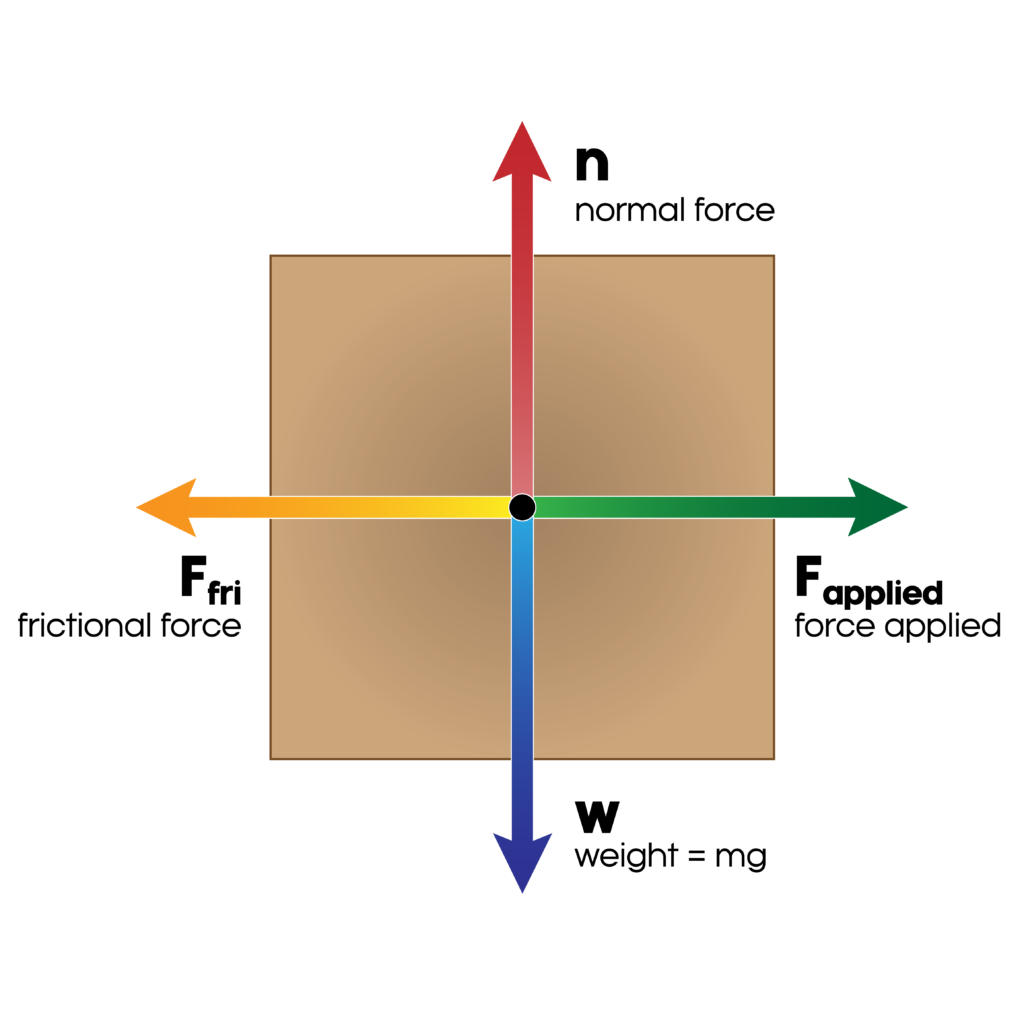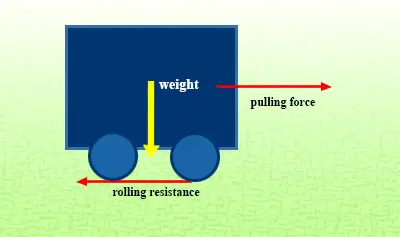Friction

In studying laws of motion, we found out that there are extraneous variables that act on the object, such as friction.
We often neglect it, but it is also an important concept that we have to understand. When an object (say, a block) is in motion along a surface (like ice), the surface exerts a force back upon the object.
The force that is perpendicular to the surface is called the normal force, while the force that is parallel to the surface is the frictional force or, simply, friction.
In this reviewer, you’ll rediscover the principles behind friction and its importance in understanding the laws of motion.
Click below to go to the main reviewers:
Table of Contents
- What Is Friction?
- Coefficient of Friction
- Static Friction
- Kinetic Friction
- Rolling Friction
- Sample Problem Involving Friction
- Solution
- Download Article in PDF Format
- Test Yourself!
What Is Friction?
Friction is the force that resists the motion of the object along the surface. Hence, its direction will always oppose the relative motion of the object.

Coefficient of Friction
Every surface has what we call a coefficient of friction which depends on its structure.
If you try sliding a block on some surfaces like sandpaper and ice, what do you notice? Which surface is smoother?
These materials have different compositions, hence, their resistance to motion is also different. The smoother the surface is, the less friction it provides.
However, from the microscopic point of view, even the surface that appears to be smooth has imperfections that provide friction. As the object slides across the surface, there are points where atoms in both the surface and the object interact with one another, causing hindrance to the motion.
The table below shows the coefficient of friction of common surfaces.
| Materials | Coefficient of Static Friction, μs | Coefficient of Kinetic Friction, μk |
| Steel on steel | 0.74 | 0.57 |
| Aluminum on steel | 0.61 | 0.47 |
| Copper on steel | 0.53 | 0.36 |
| Brass on steel | 0.51 | 0.44 |
| Zinc on cast iron | 0.85 | 0.21 |
| Copper on cast iron | 1.05 | 0.29 |
| Glass on glass | 0.94 | 0.40 |
| Copper on glass | 0.68 | 0.53 |
| Teflon on Teflon | 0.04 | 0.04 |
| Teflon on steel | 0.04 | 0.04 |
| Rubber on concrete (dry) | 1.0 | 0.8 |
| Rubber on concrete (wet) | 0.30 | 0.25 |
Static Friction
Try sliding a box across the floor. Were you able to make the box move? It may or may not move because the floor exerts an equal and opposite friction force on the box.
This is called a static frictional force, which is the friction that resists the initiation of the motion. It’s directly proportional to the normal force; hence, the heavier the object is, the greater the normal force and the frictional force.
Static friction can increase until the magnitude of the applied force is greater than the maximum static frictional force the object exerts, resulting in the acceleration of the box. Its value will be anywhere from zero to the maximum possible value, which can be calculated using
Fmax = μsn
Kinetic Friction
When the applied force exceeds the maximum static friction, the object will begin to accelerate. Once the object is in motion, it now moves against kinetic friction, which refers to the force that opposes relative sliding motion.
Kinetic friction will always be less than static friction since it is harder to get an object going than to keep it moving once you start pushing it.
The magnitude of the kinetic frictional force acting on a sliding object can be calculated using the formula,
Fk = μkn
Rolling Friction

Most of the time, instead of pushing a box to make it slide, you place the box on a cart with wheels to make it move. That is much easier, right? This is because of rolling friction, or the force that resists the motion of a rolling body on a surface. This is equal to
Fr = μrn
Sample Problem Involving Friction
A 30-kg block of ice rests on the surface. You began pushing it horizontally, and the block started moving when your force exceeds 202 N. You want to keep it moving at a constant 0.31 m/s, reducing your push to 120 N.
Find the coefficients of static and kinetic friction between the block of ice and the surface.
Solution
To understand this further, let us draw a free-body diagram.

Let us solve for the coefficient of static friction first. We know that this is equal to
Ffr = μsN
Using the free-body diagram, we know that
ΣFy = 0
ΣFy = n – mg
n = mg
n = (30 kg) (9.8 m/s2)
n = 294 N
ΣFx = 0
ΣFx = F – Ffr
Ffr = F
Ffr = 202 N
Solving for μs,
Ffr = μsn
μs = Ffr/n
μs = 202 N/294 N
μs = 0.69
For the coefficient of kinetic friction, Ffr = 120 N. Solving for μk,
μk = Ffr/n
μk = 120 N/294 N
μk = 0.41
Next topic: Work, Energy, and Power
Previous topic: Newton’s Laws of Motions
Return to the main article: The Ultimate Physics Reviewer
Download Article in PDF Format
Test Yourself!
1. Practice Questions [PDF Download]
2. Answer Key [PDF Download]
Written by Mary Joy Montenegro
Mary Joy Montenegro
Mary Joy Montenegro is a licensed professional teacher who obtained her Master’s Degree in Teaching Physics at De La Salle University under the Department of Science and Technology Scholarship. Aside from teaching, she also loves traveling and meeting other people.
Copyright Notice
All materials contained on this site are protected by the Republic of the Philippines copyright law and may not be reproduced, distributed, transmitted, displayed, published, or broadcast without the prior written permission of filipiknow.net or in the case of third party materials, the owner of that content. You may not alter or remove any trademark, copyright, or other notice from copies of the content. Be warned that we have already reported and helped terminate several websites and YouTube channels for blatantly stealing our content. If you wish to use filipiknow.net content for commercial purposes, such as for content syndication, etc., please contact us at legal(at)filipiknow(dot)net

